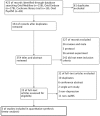Transcutaneous auricular vagus nerve stimulation in treating major depressive disorder: A systematic review and meta-analysis
- PMID: 30593183
- PMCID: PMC6314717
- DOI: 10.1097/MD.0000000000013845
Transcutaneous auricular vagus nerve stimulation in treating major depressive disorder: A systematic review and meta-analysis
Abstract
Background: Transcutaneous auricular vagus nerve stimulation (taVNS), as a noninvasive intervention, has beneficial effects on major depressive disorder based on clinical observations. However, the potential benefits and clinical role of taVNS in the treatment of major depressive disorder are still uncertain and have not been systematically evaluated. Therefore, we performed a systematic review and meta-analysis to evaluate the effectiveness and safety of taVNS in treating major depressive disorder.
Methods: Four electronic databases, namely, Embase, MEDLINE, the Cochrane Library and PsycINFO, were searched for all related trials published through May 1, 2018. We extracted the basic information and data of the included studies and evaluated the methodological quality with the Cochrane risk of bias tool and the nonrandomized studies-of interventions (ROBINS-I) tool. A meta-analysis of the comparative effects was conducted using the Review Manager 5.3 software.
Results: A total of 423 citations from the databases were searched, and 4 studies with 222 individuals were included in the meta-analysis. The taVNS technique could decrease 24-item HAMD scores more than the sham intervention (MD: -4.23, 95% CI: -7.15, -1.31; P = .005) and was also more effective in decreasing Self-Rating Depression Scale scores ((MD: -10.34, 95% CI: -13.48, -7.20; P < .00001), Beck Depression Inventory scores (MD: -10.3, 95% CI: -18.1, -2.5; P = .01) and Self-Rating Anxiety Scale scores (MD: -6.57, 95% CI: -9.30, -3.84; P < .00001). However, there was no significant difference in the Hamilton Anxiety Rating Scale scores between the taVNS and sham taVNS groups (MD: -1.12, 95% CI: -2.56, 0.32; P = .13). No obvious adverse effects of taVNS treatment were reported in the included studies.
Conclusion: The results of the analysis preliminarily demonstrated that taVNS therapy can effectively ameliorate the symptoms of major depressive disorder, providing an alternative technique for addressing depression. However, more well-designed RCTs with larger sample sizes and follow-ups are needed in future studies to confirm our findings.
Conflict of interest statement
Competing interests: The authors declare no conflict of interests regarding the publication of this paper.
Figures






Similar articles
-
Effect of transcutaneous auricular vagus nerve stimulation on major depressive disorder: A nonrandomized controlled pilot study.J Affect Disord. 2016 May;195:172-9. doi: 10.1016/j.jad.2016.02.031. Epub 2016 Feb 10. J Affect Disord. 2016. PMID: 26896810 Free PMC article. Clinical Trial.
-
The efficacy and safety of transcutaneous auricular vagus nerve stimulation in patients with mild cognitive impairment: A double blinded randomized clinical trial.Brain Stimul. 2022 Nov-Dec;15(6):1405-1414. doi: 10.1016/j.brs.2022.09.003. Epub 2022 Sep 21. Brain Stimul. 2022. PMID: 36150665 Clinical Trial.
-
Transcutaneous auricular vagus nerve stimulators: a review of past, present, and future devices.Expert Rev Med Devices. 2022 Jan;19(1):43-61. doi: 10.1080/17434440.2022.2020095. Epub 2022 Jan 13. Expert Rev Med Devices. 2022. PMID: 34937487 Review.
-
Comparative Effectiveness of Transcutaneous Auricular Vagus Nerve Stimulation vs Citalopram for Major Depressive Disorder: A Randomized Trial.Neuromodulation. 2022 Apr;25(3):450-460. doi: 10.1016/j.neurom.2021.10.021. Epub 2021 Dec 18. Neuromodulation. 2022. PMID: 35088753 Clinical Trial.
-
Safety of transcutaneous auricular vagus nerve stimulation (taVNS): a systematic review and meta-analysis.Sci Rep. 2022 Dec 21;12(1):22055. doi: 10.1038/s41598-022-25864-1. Sci Rep. 2022. PMID: 36543841 Free PMC article.
Cited by
-
Respiratory-gated auricular vagal afferent nerve stimulation (RAVANS) modulates brain response to stress in major depression.J Psychiatr Res. 2021 Oct;142:188-197. doi: 10.1016/j.jpsychires.2021.07.048. Epub 2021 Aug 2. J Psychiatr Res. 2021. PMID: 34365067 Free PMC article. Clinical Trial.
-
Transcutaneous auricular vagus nerve stimulation modifies cortical excitability in middle-aged and older adults.Psychophysiology. 2025 Jan;62(1):e14584. doi: 10.1111/psyp.14584. Epub 2024 Apr 11. Psychophysiology. 2025. PMID: 38602055 Free PMC article. Clinical Trial.
-
Effect of auriculotherapy and intervention types on weight control: A systematic review and meta-analysis protocol.Medicine (Baltimore). 2019 Aug;98(34):e16959. doi: 10.1097/MD.0000000000016959. Medicine (Baltimore). 2019. PMID: 31441898 Free PMC article.
-
Mechanisms underlying antidepressant effect of transcutaneous auricular vagus nerve stimulation on CUMS model rats based on hippocampal α7nAchR/NF-κB signal pathway.J Neuroinflammation. 2021 Dec 17;18(1):291. doi: 10.1186/s12974-021-02341-6. J Neuroinflammation. 2021. PMID: 34920740 Free PMC article.
-
Neuroregulatory Effects of Microcone Patch Stimulation on the Auricular Branch of the Vagus Nerve and the Prefrontal Cortex: A Feasibility Study.J Clin Med. 2024 Apr 20;13(8):2399. doi: 10.3390/jcm13082399. J Clin Med. 2024. PMID: 38673672 Free PMC article.
References
-
- Serafini G, Pompili M, Borgwardt S, et al. Brain changes in early-onset bipolar and unipolar depressive disorders: a systematic review in children and adolescents. Eur Child Adolesc Psychiatry 2014;23:1023–41. - PubMed
-
- Conway CR, George MS, Sackeim HA. Toward an evidence-based, operational definition of treatment-resistant depression: when enough is enough. JAMA Psychiatry 2017;74:9–10. - PubMed
-
- Peterson K, Dieperink E, Anderson J, et al. Rapid evidence review of the comparative effectiveness, harms, and cost-effectiveness of pharmacogenomics-guided antidepressant treatment versus usual care for major depressive disorder. Psychopharmacology 2017;234:1649–61. - PubMed
Publication types
MeSH terms
LinkOut - more resources
Full Text Sources

